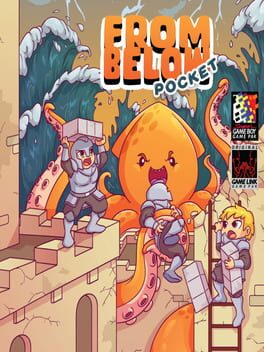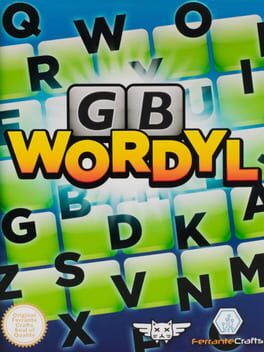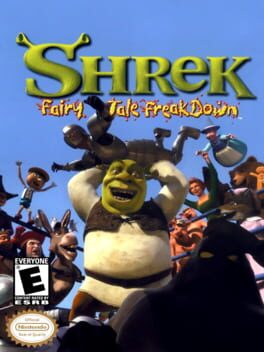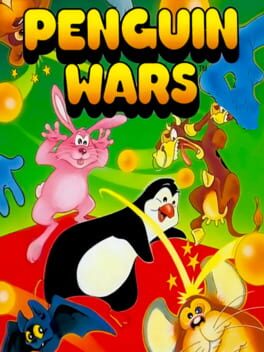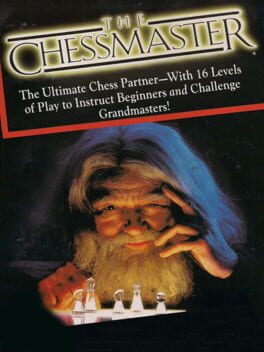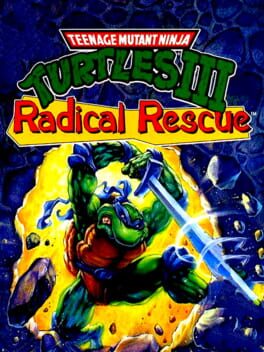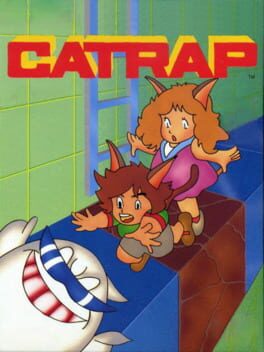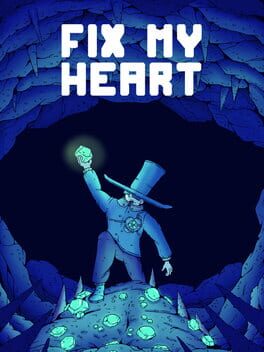GumpyFunction
Bio
Hi there, I'm an Indie Game Boy Developer from Australia.
Here you will find Game Boy reviews, both licensed and homebrew. The Homebrew I will feature are commercial games I have bought and have played primarily as a consumer so these reviews won't be a timely service. Its more a casual thought share. Happy reading!
Hi there, I'm an Indie Game Boy Developer from Australia.
Here you will find Game Boy reviews, both licensed and homebrew. The Homebrew I will feature are commercial games I have bought and have played primarily as a consumer so these reviews won't be a timely service. Its more a casual thought share. Happy reading!
Badges

Noticed
Gained 3+ followers
Favorite Games
011
Total Games Played
000
Played in 2024
000
Games Backloggd
Recently Played See More
Recently Reviewed See More
I have played TMNT3: Radical Rescue for a number of hours (but still haven't beaten it 🥵).
Teenage Mutant Ninja Turtles III: Radical Rescue is an early Gated Exploration game developed by Konami and released in 1993. Michelangelo returns to the Sewers after getting some pizza for the gang, only to find that Shredder has kidnapped the other Turtles, April O’Neil, and Splinter. It’s up to Michelangelo to save everyone!
The player is tasked with exploring a labyrinth filled with enemies, obstacles, and bosses as they try to locate Leonardo, Raphael and Donatello, who are all locked in cells dotted around the map. The game play loop is as follows:
1. Use new ability to explore expanded environment
2. Locate boss
3. Defeat boss to acquire a key
4. Locate locked cell and use the key to
5. Save the next Turtle
6. Repeat
Each Turtle you save will allow the player to switch to them, and thereby use a new ability unique to each of the reptilian pizza lovers. Michelangelo can hover using his nun-chucks, Leonardo can drill down certain blocks using his katanas, Raphael can slip inside his shell to shimmy through small holes in the walls (morph ball cough) and Donatello can cling to and climb walls.
Radical Rescue was the first ever gated exploration game to feature a modern map system. By modern I mean, you can press START, switch to a view of the all the rooms in the game and see where you are and where each room is in relation to the next. You can also see points of interest on the map (denoted by black dots in the US and EUR version) to help you figure out where to go next.
Now, here is the thing, in the JP version, those dots are swapped out for a boss marker, a key card marker (they open smaller locked doors across the map) and the cell doors with the other turtles locked behind them. This makes the Japanese version soooo much less frustrating to play and the clear choice if you want to give the game a shot yourself. Having the map show how each room is connected to each other by way of door or ladder (like in Super Metroid) would have been a welcome addition but Radical Rescue is a very early gated exploration game, so I won't hold that against it. The decision to make exploration so much harder in the western version is completely baffling. I would have given this game 3 to 3.5 stars if the Western map system was the only one available - it's that frustrating! You can find my own article breaking down the differences in the Western and Japanese version's of Radical Rescue if you are interested. The article can be found via the articles section of my website (link in profile).
As far as the graphics are concerned, this features some of the best artwork in the licensed catalogue. The backgrounds are beautifully detailed, the animations are rich with personality and the cutscenes are absolutely fantastic. The music and SFX are top notch too.
The difficulty is going to be an issue for some people (myself included). The moment to moment combat is really fun with each Turtle offering a new fighting style but the enemy design can get frustrating in the cramped corridors at times. The Boss fights are equally fun and inventive with excellently crafted fights but yes, they too are extremely challenging. As I said at the beginning of the review, I still haven't beaten this one but it's engaging and well designed enough enough to ensure I will be returning to give it another go.
Sometimes I think handheld games are criminally overlooked when it comes to recognizing their contribution to innovation in game design and Teenage Mutant Ninja Turtles III: Radical Rescue would be one of the prime examples in my opinion. After all, this particular game’s map system marked a considerable step forward in the genre and, more importantly, the game itself acts as a precursor to Konami’s own Castlevania: Symphony of the Night, literally the defining title in the Metroidvania genre.
Teenage Mutant Ninja Turtles III: Radical Rescue is an early Gated Exploration game developed by Konami and released in 1993. Michelangelo returns to the Sewers after getting some pizza for the gang, only to find that Shredder has kidnapped the other Turtles, April O’Neil, and Splinter. It’s up to Michelangelo to save everyone!
The player is tasked with exploring a labyrinth filled with enemies, obstacles, and bosses as they try to locate Leonardo, Raphael and Donatello, who are all locked in cells dotted around the map. The game play loop is as follows:
1. Use new ability to explore expanded environment
2. Locate boss
3. Defeat boss to acquire a key
4. Locate locked cell and use the key to
5. Save the next Turtle
6. Repeat
Each Turtle you save will allow the player to switch to them, and thereby use a new ability unique to each of the reptilian pizza lovers. Michelangelo can hover using his nun-chucks, Leonardo can drill down certain blocks using his katanas, Raphael can slip inside his shell to shimmy through small holes in the walls (morph ball cough) and Donatello can cling to and climb walls.
Radical Rescue was the first ever gated exploration game to feature a modern map system. By modern I mean, you can press START, switch to a view of the all the rooms in the game and see where you are and where each room is in relation to the next. You can also see points of interest on the map (denoted by black dots in the US and EUR version) to help you figure out where to go next.
Now, here is the thing, in the JP version, those dots are swapped out for a boss marker, a key card marker (they open smaller locked doors across the map) and the cell doors with the other turtles locked behind them. This makes the Japanese version soooo much less frustrating to play and the clear choice if you want to give the game a shot yourself. Having the map show how each room is connected to each other by way of door or ladder (like in Super Metroid) would have been a welcome addition but Radical Rescue is a very early gated exploration game, so I won't hold that against it. The decision to make exploration so much harder in the western version is completely baffling. I would have given this game 3 to 3.5 stars if the Western map system was the only one available - it's that frustrating! You can find my own article breaking down the differences in the Western and Japanese version's of Radical Rescue if you are interested. The article can be found via the articles section of my website (link in profile).
As far as the graphics are concerned, this features some of the best artwork in the licensed catalogue. The backgrounds are beautifully detailed, the animations are rich with personality and the cutscenes are absolutely fantastic. The music and SFX are top notch too.
The difficulty is going to be an issue for some people (myself included). The moment to moment combat is really fun with each Turtle offering a new fighting style but the enemy design can get frustrating in the cramped corridors at times. The Boss fights are equally fun and inventive with excellently crafted fights but yes, they too are extremely challenging. As I said at the beginning of the review, I still haven't beaten this one but it's engaging and well designed enough enough to ensure I will be returning to give it another go.
Sometimes I think handheld games are criminally overlooked when it comes to recognizing their contribution to innovation in game design and Teenage Mutant Ninja Turtles III: Radical Rescue would be one of the prime examples in my opinion. After all, this particular game’s map system marked a considerable step forward in the genre and, more importantly, the game itself acts as a precursor to Konami’s own Castlevania: Symphony of the Night, literally the defining title in the Metroidvania genre.
Known as Pitman in Japan, Catrap is a puzzle platform game first released on the Sharp MZ-700 computer in 1985 and later developed for the Nintendo Game Boy by Asmik in 1990.
I have played Catrap for many hours having first stumbled upon it as a child.
The following sample is taken from the Design Analysis Spotlight article I did on Catrap for GBSC. You can read the full article via my website (link in Profile):
~~~
Have you ever found yourself jumping into a brand new game, only to find that the tutorials within are so lengthy and word heavy that all the wind has been taken out of your sails before you had a chance to really dive in?
Conveying the ‘how to play’ information for any game can easily become bogged down in long winded text boxes and time consuming step by step, hand holding exercises. It’s a common problem in game design, and a difficult one to solve. And while some genres will always lend themselves to relatively more complex control schemes and game mechanics than others, when it comes to the humble tutorial, there are some things to keep in mind to ensure your game doesn’t weigh itself down so much that it ends up sinking.
Back when games came packaged in cardboard boxes, complete with detailed instruction manuals, game designers didn’t necessarily need to worry about in-game tutorials. Players were expected to do a little light reading before they switched on the game, pressed start and were sent on their merry way. With the rise of digital downloads (and I like to think a little consideration for environmental conservation), the industry shifted away from the paper instruction manual and has been solving the problem of in-game tutorials ever since. In this respect, there is one game that was well ahead of the curve. Catrap not only doesn’t require you to sit down and read through a manual before playing, its in-game tutorials elegantly teach you the rules of play without a single word!
End of article Sample.
~~~
Because of its elegant tutorial design and excellent puzzle design in general, Catrap is one of the best puzzlers you will find in the licensed DMG Game Boy library.
There are 100 puzzles in total, the first 99 of which you can access from the outset, with the option to complete them in any order. The 100th puzzle is unlocked when you complete the previous 99 (don't worry, there is a password system to keep track of your progress). I will say I still haven't completed all 100 puzzles. I find some of the latter puzzles to be overly convoluted and "too big for their own good".
There is a fully realized, highly polished puzzle creating tool built in to the game, a feature I personally feel is well ahead of its time. It's a great time challenging your friends to a puzzle of your own creation.
Catrap is a fantastic retro puzzle game and one that is particularly near and dear to my heart despite the sometimes frustrating late game puzzle design. It even has a move undo function that remembers your last 100 moves or something crazy like that. Quite a nice feature for a puzzle game made in 1990 for the GB. It's well worth checking out.
If you find yourself wanting more Catrap puzzle action, Matt Hughson created a kind of spiritual successor Catrap Clone if you will in "Witch n' Wiz" for the NES in 2022. Complete with all new mechanics built off the excellent foundation that is Catraps central 2D sukoban-esque push mechanic, you are sure to find something special there, too.
I have played Catrap for many hours having first stumbled upon it as a child.
The following sample is taken from the Design Analysis Spotlight article I did on Catrap for GBSC. You can read the full article via my website (link in Profile):
~~~
Have you ever found yourself jumping into a brand new game, only to find that the tutorials within are so lengthy and word heavy that all the wind has been taken out of your sails before you had a chance to really dive in?
Conveying the ‘how to play’ information for any game can easily become bogged down in long winded text boxes and time consuming step by step, hand holding exercises. It’s a common problem in game design, and a difficult one to solve. And while some genres will always lend themselves to relatively more complex control schemes and game mechanics than others, when it comes to the humble tutorial, there are some things to keep in mind to ensure your game doesn’t weigh itself down so much that it ends up sinking.
Back when games came packaged in cardboard boxes, complete with detailed instruction manuals, game designers didn’t necessarily need to worry about in-game tutorials. Players were expected to do a little light reading before they switched on the game, pressed start and were sent on their merry way. With the rise of digital downloads (and I like to think a little consideration for environmental conservation), the industry shifted away from the paper instruction manual and has been solving the problem of in-game tutorials ever since. In this respect, there is one game that was well ahead of the curve. Catrap not only doesn’t require you to sit down and read through a manual before playing, its in-game tutorials elegantly teach you the rules of play without a single word!
End of article Sample.
~~~
Because of its elegant tutorial design and excellent puzzle design in general, Catrap is one of the best puzzlers you will find in the licensed DMG Game Boy library.
There are 100 puzzles in total, the first 99 of which you can access from the outset, with the option to complete them in any order. The 100th puzzle is unlocked when you complete the previous 99 (don't worry, there is a password system to keep track of your progress). I will say I still haven't completed all 100 puzzles. I find some of the latter puzzles to be overly convoluted and "too big for their own good".
There is a fully realized, highly polished puzzle creating tool built in to the game, a feature I personally feel is well ahead of its time. It's a great time challenging your friends to a puzzle of your own creation.
Catrap is a fantastic retro puzzle game and one that is particularly near and dear to my heart despite the sometimes frustrating late game puzzle design. It even has a move undo function that remembers your last 100 moves or something crazy like that. Quite a nice feature for a puzzle game made in 1990 for the GB. It's well worth checking out.
If you find yourself wanting more Catrap puzzle action, Matt Hughson created a kind of spiritual successor Catrap Clone if you will in "Witch n' Wiz" for the NES in 2022. Complete with all new mechanics built off the excellent foundation that is Catraps central 2D sukoban-esque push mechanic, you are sure to find something special there, too.
I have played Fix My Heart for 30 minutes. I purchased the Digital Edition from Incube8's website.
Synopsis from Incube8's website:
~~~
Fix My Heart is a precision platformer with minimalistic graphics and a strong emphasis on speedrunning, ranked 16th out of 134 entries in the Game Boy Competition 2021.
Run through a perilous cave as you try to fix your mechanical heart. The game offers challenging levels that will push your platforming abilities to the limit, leaving no room for errors. Are you up for the challenge?
With seven unique endings to unlock, you must decide your fate and confront the cave's deadly obstacles. For those seeking an even harder experience, the Remix mode introduces five new gameplay mechanics that will put your skills to the test.
~~~
I was interested in the full release of this game as I not only love platformers, I love speedrunning platformers that focus on precision movement. I was looking forward to a modernized platforming challenge for the Game Boy Color from developer Filipe Bianchin having played and enjoyed his GBCompo21 jam version of the same name.
There are two modes to choose from: a "Story Mode", where you sprint through a cave racing against time, seeking out several unique endings. And the additional "Remix Mode" that separates the full release from the jam version. The Remix mode challenges the player to complete a series of rooms, each with its own unique gimmick including a Mario Odyssey style throw your hat and use it as a trampoline or a flappy bird jet pack section, for example.
This is the first release from developer Filipe Bianchin and it shows considerable promise for future releases. He has a strong handle on game juice and making sure the Player Character feels responsive. The minimalist pixel art is very nice and effective as a stylistic choice and the game play itself is simple but effective. However, as this is a commercial release that I spent money on, there are some issues I think are important to raise.
STORY MODE
----------------------
I completed the Story Mode in 3 minutes. There is some replay value here as there are multiple endings. This is a similar experience to the jam version as there are multiple endings to find in that, too. But I found a bunch of them very quickly. Most of them completed within 15 minutes of game play. There are no enemies in this game, just you and precision jumping which I found to be pretty easy. So the game play is fun, but it is simplistic for a story mode that last 3 minutes and doesn't encourage replay over all. It's simply not complex enough.
The one ending I wanted to experience most of all is the deathless run as that is the most challenging of the runs and I felt the game could provide some challenge through reaching this goal. I spent 10 minutes attempting a deathless run of the Story Mode but retired for one big reason...There is no quick run reset. So if I died at any time during a deathless attempt, I couldn't pause the game and select a run reset option. I had to reset the actual Game Boy and sit there waiting through Logo screens, menues and a short version of the intro cutscene. In the end, I was watching logos and cutscenes for a longer period of time than attempting runs. It was enough for me to just stop trying. I do hope this feature is added into at least the digital edition of the game to help speedrunners looking to complete the deathless run in future. This is a platformer that strongly stresses speed running at the core of its design, after all.
~~~
REVIEW EDIT:
After releasing this review, the developer contacted me and mentioned you can restart to the Title Screen during a run by pressing START and SELECT at the same time. In the manual, under the controls section, it does say "RESTART" and points to the SELECT and START button.
So there is a quick game restart, at least.
I read the manual but missed this detail, unfortunately. This does raise an interesting point, though. Do modern players skim through a manual or not read it at all? Should developers insert important information into the game to ensure the player has an optimally designed experience? Or does the Developer leave it to chance, hoping that players will read through the manual? From my own feedback, I tend to think players won't read the instructions on itch or a manual, and just dive in like you would a modern game, expecting all the tutorials to be baked in to the game design. In this case, I think putting in a pause menu with the option to quick restart the run you are attempting from the "RUN" screen would be the best solution. Play testing is the key to solving this on a case by case basis, in any case.
So, yes, you can actually quick restart to title screen in Fix My Heart. It doesn't reset the run as quickly as I would like as you will need to re-select game modes in the menu and sit through a section of the intro sequence each time, but skipping the logo screens is enough to make me want to go back and attempt that deathless run again.
END OF REVIEW EDIT
~~~
There is also no DMG lockout screen and if you use a DMG and select one of the two pixel art modes, you end up with a white screen during game play. Playing on DMG also experiences severe slow down, making the game practically unplayable. If its a GBC exclusive game, then DMG lockout screens are there to prevent a player from playing the game in an unintended way. This is also an easy fix for a future update.
REMIX MODE
----------------------
There are some very neat ideas in Remix Mode when it comes to the gimmicks in each room. And they are executed well in a coding and game feel sense. I completed this mode in 5 minutes though, and once you complete it, there isn't much reason to go back and do it again. I felt like this mode was more of a tech demo of varying mechanics rather than a fleshed out experience that could be called a stand alone mode in a commercial game. Following through with these ideas and introducing enemies or obstacles beyond the platforms and spikes that seek to counter each new gimmick in an interesting way would have been fantastic to see.
The player is tasked with simply reaching the end of this mode, not under a time constraint. Some of the sections (especially the very last section) inflate the difficulty to near frame perfect precision by asking the player to become a machine. Each room acts as a checkpoint thankfully, which is needed because I feel most players will find this mode to be very frustrating for its frame perfect difficulty built into the design of the level layouts. Frame perfect execution is a slippery slope of a difficulty curve and can cause player drop off when not handle well.
CONCLUSION
----------------------
Reading this critique, you may think I would call Fix My Heart a "bad" game.
Not at all!
Platformers are an extremely challenging genre when it comes to design and Fix My Heart is an excellent first release from a young developer. In fact, I think its comparable or even better than my own first release 'In The Dark', which I would award 2.5 stars if I had to attempt to objectively critique my own game, for similar reasons - code is great, but the mechanics aren't deep enough and it lacks enough content for a commercial release. (In fact, Filipe's first release is even more impressive in that platformers are significantly harder to make well compared to puzzle games, in my view, at least. So it's doubly impressive to see such an excellent first attempt.) I was disappointed with the amount of content in this game given its a commercial release and it says there will be "a lot of new content (new game modes)" on the jam versions itch page. While on the simple side, the moment to moment game play is enjoyable and aspects such as game feel, SFX, player animations and movement are greatly improved over the jam version.
Filipe, you should be proud of this achievement, no doubt. But Fix My Heart could have used a lot more play testing before its release. Don't be discouraged Filipe, you are a fantastic developer and starting out on a successful game dev journey. Remember: Game Dev is not about making the best game ever, its about making a better game than your last one.
Here are some Pros and Cons that will help you improve your next platformer. Good luck!
PROS
---------
- Excellent understanding of game juice. Nice animations, SFX and great Player Character physics.
- GFX are stylish and provide excellent readability while twitch platforming.
- Some great player mechanic gimmick ideas that feel very fun to play with in the Remix Mode.
CONS
---------
- Not speedrunner friendly.
- Lacks a pause game feature.
- Lacks a DMG lock out screen for what is a GBC exclusive.
- Level Design difficulty artificially peaks using sometimes cheap and frustrating frame perfect level layouts.
- Obstacle mechanic design is simplistic, only offering platforms and spikes.
- Remix Mode could have been expanded on with enemies that counter each of the new movesets given to the Player Character to provide a richer and more varied platforming experience.
- Not much additional content over the free jam version.
Synopsis from Incube8's website:
~~~
Fix My Heart is a precision platformer with minimalistic graphics and a strong emphasis on speedrunning, ranked 16th out of 134 entries in the Game Boy Competition 2021.
Run through a perilous cave as you try to fix your mechanical heart. The game offers challenging levels that will push your platforming abilities to the limit, leaving no room for errors. Are you up for the challenge?
With seven unique endings to unlock, you must decide your fate and confront the cave's deadly obstacles. For those seeking an even harder experience, the Remix mode introduces five new gameplay mechanics that will put your skills to the test.
~~~
I was interested in the full release of this game as I not only love platformers, I love speedrunning platformers that focus on precision movement. I was looking forward to a modernized platforming challenge for the Game Boy Color from developer Filipe Bianchin having played and enjoyed his GBCompo21 jam version of the same name.
There are two modes to choose from: a "Story Mode", where you sprint through a cave racing against time, seeking out several unique endings. And the additional "Remix Mode" that separates the full release from the jam version. The Remix mode challenges the player to complete a series of rooms, each with its own unique gimmick including a Mario Odyssey style throw your hat and use it as a trampoline or a flappy bird jet pack section, for example.
This is the first release from developer Filipe Bianchin and it shows considerable promise for future releases. He has a strong handle on game juice and making sure the Player Character feels responsive. The minimalist pixel art is very nice and effective as a stylistic choice and the game play itself is simple but effective. However, as this is a commercial release that I spent money on, there are some issues I think are important to raise.
STORY MODE
----------------------
I completed the Story Mode in 3 minutes. There is some replay value here as there are multiple endings. This is a similar experience to the jam version as there are multiple endings to find in that, too. But I found a bunch of them very quickly. Most of them completed within 15 minutes of game play. There are no enemies in this game, just you and precision jumping which I found to be pretty easy. So the game play is fun, but it is simplistic for a story mode that last 3 minutes and doesn't encourage replay over all. It's simply not complex enough.
The one ending I wanted to experience most of all is the deathless run as that is the most challenging of the runs and I felt the game could provide some challenge through reaching this goal. I spent 10 minutes attempting a deathless run of the Story Mode but retired for one big reason...There is no quick run reset. So if I died at any time during a deathless attempt, I couldn't pause the game and select a run reset option. I had to reset the actual Game Boy and sit there waiting through Logo screens, menues and a short version of the intro cutscene. In the end, I was watching logos and cutscenes for a longer period of time than attempting runs. It was enough for me to just stop trying. I do hope this feature is added into at least the digital edition of the game to help speedrunners looking to complete the deathless run in future. This is a platformer that strongly stresses speed running at the core of its design, after all.
~~~
REVIEW EDIT:
After releasing this review, the developer contacted me and mentioned you can restart to the Title Screen during a run by pressing START and SELECT at the same time. In the manual, under the controls section, it does say "RESTART" and points to the SELECT and START button.
So there is a quick game restart, at least.
I read the manual but missed this detail, unfortunately. This does raise an interesting point, though. Do modern players skim through a manual or not read it at all? Should developers insert important information into the game to ensure the player has an optimally designed experience? Or does the Developer leave it to chance, hoping that players will read through the manual? From my own feedback, I tend to think players won't read the instructions on itch or a manual, and just dive in like you would a modern game, expecting all the tutorials to be baked in to the game design. In this case, I think putting in a pause menu with the option to quick restart the run you are attempting from the "RUN" screen would be the best solution. Play testing is the key to solving this on a case by case basis, in any case.
So, yes, you can actually quick restart to title screen in Fix My Heart. It doesn't reset the run as quickly as I would like as you will need to re-select game modes in the menu and sit through a section of the intro sequence each time, but skipping the logo screens is enough to make me want to go back and attempt that deathless run again.
END OF REVIEW EDIT
~~~
There is also no DMG lockout screen and if you use a DMG and select one of the two pixel art modes, you end up with a white screen during game play. Playing on DMG also experiences severe slow down, making the game practically unplayable. If its a GBC exclusive game, then DMG lockout screens are there to prevent a player from playing the game in an unintended way. This is also an easy fix for a future update.
REMIX MODE
----------------------
There are some very neat ideas in Remix Mode when it comes to the gimmicks in each room. And they are executed well in a coding and game feel sense. I completed this mode in 5 minutes though, and once you complete it, there isn't much reason to go back and do it again. I felt like this mode was more of a tech demo of varying mechanics rather than a fleshed out experience that could be called a stand alone mode in a commercial game. Following through with these ideas and introducing enemies or obstacles beyond the platforms and spikes that seek to counter each new gimmick in an interesting way would have been fantastic to see.
The player is tasked with simply reaching the end of this mode, not under a time constraint. Some of the sections (especially the very last section) inflate the difficulty to near frame perfect precision by asking the player to become a machine. Each room acts as a checkpoint thankfully, which is needed because I feel most players will find this mode to be very frustrating for its frame perfect difficulty built into the design of the level layouts. Frame perfect execution is a slippery slope of a difficulty curve and can cause player drop off when not handle well.
CONCLUSION
----------------------
Reading this critique, you may think I would call Fix My Heart a "bad" game.
Not at all!
Platformers are an extremely challenging genre when it comes to design and Fix My Heart is an excellent first release from a young developer. In fact, I think its comparable or even better than my own first release 'In The Dark', which I would award 2.5 stars if I had to attempt to objectively critique my own game, for similar reasons - code is great, but the mechanics aren't deep enough and it lacks enough content for a commercial release. (In fact, Filipe's first release is even more impressive in that platformers are significantly harder to make well compared to puzzle games, in my view, at least. So it's doubly impressive to see such an excellent first attempt.) I was disappointed with the amount of content in this game given its a commercial release and it says there will be "a lot of new content (new game modes)" on the jam versions itch page. While on the simple side, the moment to moment game play is enjoyable and aspects such as game feel, SFX, player animations and movement are greatly improved over the jam version.
Filipe, you should be proud of this achievement, no doubt. But Fix My Heart could have used a lot more play testing before its release. Don't be discouraged Filipe, you are a fantastic developer and starting out on a successful game dev journey. Remember: Game Dev is not about making the best game ever, its about making a better game than your last one.
Here are some Pros and Cons that will help you improve your next platformer. Good luck!
PROS
---------
- Excellent understanding of game juice. Nice animations, SFX and great Player Character physics.
- GFX are stylish and provide excellent readability while twitch platforming.
- Some great player mechanic gimmick ideas that feel very fun to play with in the Remix Mode.
CONS
---------
- Not speedrunner friendly.
- Lacks a pause game feature.
- Lacks a DMG lock out screen for what is a GBC exclusive.
- Level Design difficulty artificially peaks using sometimes cheap and frustrating frame perfect level layouts.
- Obstacle mechanic design is simplistic, only offering platforms and spikes.
- Remix Mode could have been expanded on with enemies that counter each of the new movesets given to the Player Character to provide a richer and more varied platforming experience.
- Not much additional content over the free jam version.

